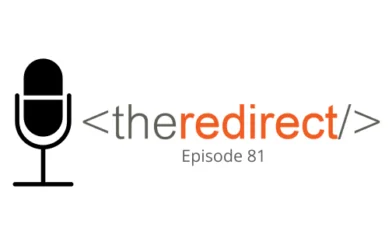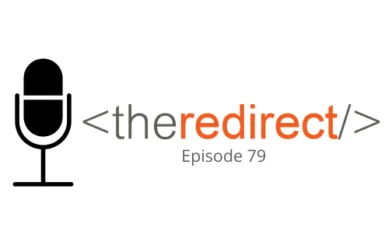Episode 48 / June 1, 2018
Listen now:
Welcome to The Redirect Podcast, where the BlackTruck team shares recent insights and takeaways from the world of search marketing.
In this week’s episode:
- Insights on what came out of Mary Meeker’s 2018 Internet Trends report includes a few key areas search marketers should pay attention to—specifically, a lot of talk centered around mobile (begins at 2:04).
- The challenges and questions surrounding splitting a single website off into “microsites,” and the impact this could have on your brand and how search engines perceive it (begins at 15:45).
- Google again giveth and taketh away on a feature inside of image search that has impacted traffic to sites (begins at 23:25).
Mary Meeker’s 2018 Internet Trends Report
It’s that time of year again! Mary Meeker recently shared her famed internet trends report for 2018, reviewing trends from 2017 data. Some observations from the 2017 data:
- Time spent on mobile devices has continued to increase, as shown on slide 11 by the average hours spent per day with digital media in 2017 (per adult user):
- 3.3 hours on mobile
- 2.1 on desktop/laptop
- 0.6 hours on “other connected devices”
- This totals 5.9 hours per day, a 4% growth over last year’s 5.6 hours per day
- We’ve talked a lot about voice assistants on the podcast in the past; “Other connected devices” appears to be growing very slightly year over year (slide 11).
- New smartphone shipments have dropped again, implying we’ve reached the saturation point where pretty much everyone and their brother has a smartphone.
- 60% of reported everyday transactions “over the past 10 days” were done digitally vs. in-store (slide 18). Three percent of these were done from a smart home device.
- Google reached the 95% threshold for human accuracy in machine learning word accuracy in 2017 (slide 25).
- Even in this age of data breaches, per Deloitte, 79% of US consumers are willing to share personal data for “clear personal benefit” (slide 205).
Flip through all 294 slides below, or see Recode’s great compilation of takeaways.
Takeaway: It was previously anticipated that by the end of 2017, 75% of the content you consume would be on a mobile device. Meeker’s data recap further reinforces that we live in a mobile world, and it will only continue to grow. Are you marketing to a mobile audience?
How Will Splitting a Website Affect SEO?
Recently, we have run into multiple situations that have involved our team advising clients and agency teams on whether or not they should split off a site into multiple sites, or stick with just the one single site covering different focuses areas or arms of the business or organization.
As luck would have it, a question came up recently on Twitter in comments from Google’s John Mueller around the risks of breaking up a site into two different ones, handling it via redirects, etc.
Mueller points out that when you split a site into different properties, you now have two sites that must each rank on their own. So the question then comes back to this: Are the two sites as visible in search as the original single site was? Jennifer Slegg at TheSEMPost followed this conversation closely and went on to document the reminders from Mueller that “whenever a site redirects to another page or site, there is a delay where Google is re-crawling and matching up old pages to new pages with redirects, etc.”
While this is a great point, and understanding that it totally can take longer for Google to go through and reprocess what has existed in the past, we must go back to the root question of, “Why are we separating the sites in the first place?” If there is a sound strategy and initiative behind splitting a site into two or more sites, as well as potential for each site to be able to rank independently among its competition, and sound SEO strategy applied to both sites, then it’s likely that any short-term losses in terms of site visibility will be worth it once the sites start ranking independently.
Takeaway: While every situation is unique, this is not a decision to be made lightly if you’re concerned about your brand’s/brands’ online performance. Speaking for ourselves, while SEOs will definitely have opinions and input on a brand’s decision to split up a site, we can work with whatever the brand ultimately decides to do. Most importantly, understand it may take some time for the benefits of a strategic split to truly show in analytics and rankings.
Image SEO Makes a Comeback
In January 2013, Google gave us a feature. On Valentine’s Day in 2018, they quietly took it away. (Read more from Search Engine Land.)
Since that change, certain segments have seen a 37% increase in clicks to their website from Google.
What is this feature? The “View Image” button in Google image search. In 2018, Google removed the button after making a deal with Getty Images to help reduce copyright infringement. From a Google SearchLiaison tweet at the time of the change: “The Visit button remains, so users can see images in the context of the webpages they’re on.”
Let image optimization live long and prosper!
The 37% increase in clicks from image search referenced above comes from a study on Google clicks from 58 different worldwide properties that could be categorized as either entertainment, photography, or news, with most participants in the survey being news. All 58 participants had a significant catalog of at least 100,000 images. The only metric reported was image clicks. (Read more about this study at Search Engine Land.)
By the way, image clicks from Google is something you can monitor for your own site in Google Search Console. Navigate to Search Analytics > Search Type > Images, and view click data.
With this new change possibly bringing an increase in visitors to your site, it is a perfect time to re-evaluate the optimization of your images beyond the file size—especially if you are an image heavy/image-friendly industry. For us here at BlackTruck, we’re not that image-heavy, so image search does not impact us as much. But for a commerce site that has many images in a product catalog, this could make quite an impact. Of course, there’s value in having those images live on appealing pages that might entice searchers to spend more time on or dig deeper into your site once they’ve landed there.
Takeaway: Take advantage of this change Google by optimizing images on your site for image search. Monitor clicks from image search in Google Search Console, and monitor any changes in traffic and engagement in Google Analytics for pages on which images have been optimized.
Thanks for tuning in! To catch future episodes of The Redirect Podcast, subscribe on SoundCloud, iTunes, or Stitcher.




